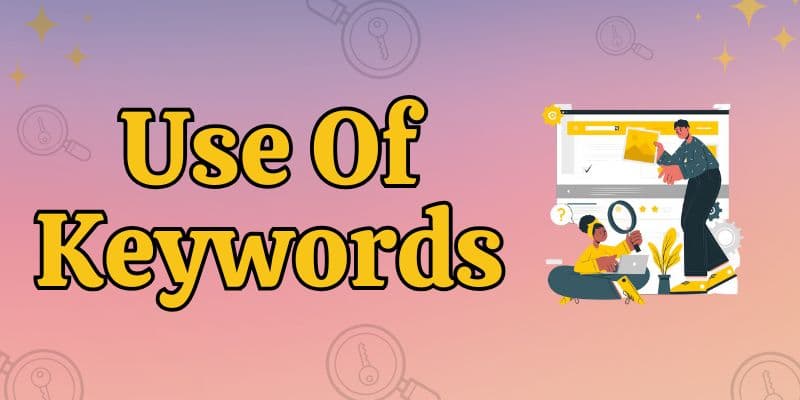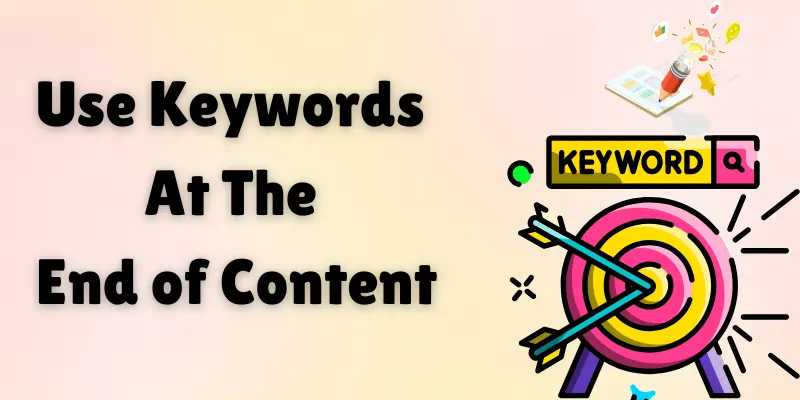What are SEO Keywords & How to Use Keywords in Content
Keywords are essential in driving your website to the top of the search engine results page. It is straightforward to choose the right keywords for your content. Pick your keywords; make a list of them; then select the primary and secondary keywords and start adding them to a webpage.
But what are the SEO keywords? And how to use keywords on your website for quick indexing?
This article will cover what keywords are and why they are essential. And what are the types of keywords, and where to use them on your web pages?
Let's get into the body of the article.
What Are SEO Keywords?
A keyword is a combination of words or phrases that users type into search engines to find specific topics, products, or services.
Keywords can vary in type, such as competitive, uncompetitive, commercial, or informational. For example, if you're looking for information on computer hardware, you might use keywords like "how many types of computer hardware" or "buy computer hardware parts."
It's important to note that SEO keywords are often more than just one word; they are usually phrases that better capture what users are searching for.
Why Are SEO Keywords Important?
SEO keywords are essential because they help search engines like Google understand the content of your page or post. Keywords act as clues, showing Google what your content is about and how it aligns with users' search queries.

Moreover, keywords are not just for search engines—they help you connect with your target audience. Choosing the right type of SEO keywords ensures your content reaches the right people, whether you're aiming for informational, commercial, or transactional intent.
So, guys, using keywords naturally in your content is equally important. How can you do this for that? Just get into the section!
Where & How to Use SEO Keywords in Content?
This section will cover all possible points where you can easily use SEO keywords to improve visibility and rankings.

Here am taking an example of keyword "SEO Tips".
Start of the Content
The start of the content is the first part of your article or webpage. This includes everything that introduces the topic to your readers and search engines.
It is the most important section for SEO because it sets the tone and helps search engines understand what your page is about. Here’s how you can use keywords at the start of your content:
1. Title (H1)
The title is the heading at the top of your page. It is also called the H1 tag. Search engines and readers see this first, so including your main keyword here is important.
How to do it:
- Use your main keyword naturally in the title.
- Keep it short and clear, around 50–60 characters.
- Example: If your keyword is "SEO Tips," your title can be "10 Best SEO Tips to Boost Your Website Traffic".
2. Meta Description
The meta description is a short summary of your page that appears under the title in search engine results.
How to do it:
- Add your keyword naturally in the description.
- Keep it under 160 characters.
- Example: "Learn the best SEO tips to increase your website traffic and improve your rankings easily."
3. URL (Slug)
The URL, or slug, is the web address of your page. It appears in the browser and in search results.
How to do it:
- Add the keyword to the URL.
- Keep the URL short and simple.
- Example: If your title is "10 Best SEO Tips," your URL can be www.example.com/seo-tips.
4. First 200 Words (Introduction)
The first 200 words of your content introduce the topic. It is often called the introduction.
How to do it:
- Use your keyword naturally in the first paragraph.
- Write clear and engaging sentences to hook the reader.
- Example: "Are you struggling to improve your website's ranking? Learning SEO tips can make a big difference."
5. Opening Sentence
The opening sentence is the first line of your content. It should grab attention immediately.
How to do it:
- Place the keyword naturally in the first sentence.
- Make it simple and engaging.
- Example: "SEO tips are essential if you want to increase your website traffic."
6. Headers and Subheaders (H2, H3, H4, etc.)
Headers and subheaders organize your content into sections. They make your page easier to read and help search engines understand the structure.
How to do it:
- Use your main keyword in at least one header.
- Use related keywords in subheaders.
- Example:
-
-
- H2: Best SEO Tips for Beginners
- H3: How to Use Keywords Effectively
-
Throughout the Content
The content section refers to the main body of your article or webpage. This is where you provide detailed information, answer questions, and engage your readers.

Using keywords strategically here ensures your content stays relevant and ranks better on search engines.
Let’s explore how to use keywords in detail:
1. Body Text (Naturally Throughout the Content)
The body text is the main part of your content, where you explain and provide detailed information.
How to do it:
- Spread keywords evenly throughout the content.
- Use them naturally without overstuffing.
- Example: "SEO tips can boost your website's ranking effectively."
2. Bullet Points and Numbered Lists
Bullet points and numbered lists are used to organize information in a simple, scannable format.
How to do it:
- Add keywords in the main points or items.
- Keep the text concise but relevant to the keyword.
- Example:
- "Optimize your title with SEO keywords."
- "Use alt-tags with keywords for better image SEO."
3. Anchor Text (Internal and External Links)
Anchor text is the clickable text used for hyperlinks in your content.
How to do it:
- Use your main keyword as anchor text for internal links.
- For external links, use related keywords or descriptive text.
- Example: "Check out our guide on SEO tips for beginners."
4. Alt-Tags for Images
Alt-tags are the descriptions you add to images for accessibility and SEO.
How to do it:
- Write short, descriptive tags including keywords.
- Avoid keyword stuffing; keep it natural.
- Example: "Graph showing SEO tips for better ranking."
5. Image Captions and Descriptions
Image captions are the text below images, and descriptions explain the image’s content.
How to do it:
- Add a clear, keyword-rich caption under images.
- Use keywords in the image description to provide context.
- Example: "This image illustrates how to use SEO tips effectively."
6. Embedded Video Descriptions
Video descriptions explain the content of embedded videos on your page.
How to do it:
- Write a short description with relevant keywords.
- Ensure the description matches the video content.
- Example: "Watch this video to learn quick SEO tips for better website performance."
7. Tables and Charts Titles/Descriptions
Tables and charts often summarize important data or comparisons in your content.
How to do it:
- Add a descriptive title or caption using keywords.
- Keep the text relevant to the content of the chart or table.
- Example: "SEO Tips Table: Comparison of Strategies for 2024."
8. Blockquotes
Blockquotes highlight important quotes or references in your content.
How to do it:
- Add keywords in the text leading to or summarizing the blockquote.
- Avoid forcing keywords into the quoted text itself.
- Example: "As the expert says, 'SEO tips are essential for online success.'"
9. Testimonials or Reviews
Testimonials or reviews add credibility and social proof to your page.
How to do it:
- Include keywords in the introduction or summary of the testimonial.
- Avoid forcing keywords into customer statements.
- Example: "This SEO tool helped me apply effective tips easily."
10. FAQ Sections
FAQ sections answer common questions related to your content topic.
How to do it:
- Use keywords in the questions and answers.
- Keep the answers short and informative.
- Example: "Q: What are the best SEO tips? A: Start with optimizing your title and content."
11. Call-to-Actions (CTAs)
CTAs guide users to take action, like subscribing or clicking a link.
How to do it:
- Use action-oriented phrases with keywords.
- Make them clear and engaging.
- Example: "Learn more SEO tips—click here to download the guide."
12. Transition Sentences Between Sections
Transition sentences help guide readers smoothly from one section to another.
How to do it:
- Use keywords naturally while summarizing or previewing content.
- Keep the sentences short and clear.
- Example: "Now that you know these SEO tips, let’s explore their benefits."
13. In Synonyms or Related Terms for Keyword Variations
Using synonyms or related terms makes your content richer and avoids repetition.
How to do it:
- Replace the main keyword with similar terms throughout the content.
- Use tools to find related words that match your topic.
- Example: "SEO strategies" instead of "SEO tips."
End of the Content

The end of the content refers to the final section of your webpage or article. It’s where you summarize your points, provide key takeaways, and leave a lasting impression on your readers.
Using keywords here helps reinforce your content’s focus and improves search engine recognition.
1. Conclusion Paragraph
The conclusion is where you wrap up your content and provide a closing thought or call to action.
How to do it:
- Restate your main keywords naturally to emphasize the topic.
- Keep the tone actionable and engaging.
- Example: "By applying these SEO tips, you can improve your website’s ranking and reach your audience effectively."
2. Summary or Key Takeaways
This section highlights the most important points covered in the content, often in a bulleted or numbered format.
How to do it:
- Include keywords in concise sentences summarizing each major point.
- Ensure the takeaways reflect the overall theme of the content.
- Example:
- "Use keywords in your title and meta description."
- "Place keywords naturally throughout the body text."
- "Don’t forget to optimize images with alt-tags and captions."
Outside Main Content (Supplementary Areas)
The outside main content section of your website is where the extra parts go that help with navigation, structure, and the user experience.
These areas are often strategically important for SEO, and you can use keywords to make your website more visible in these areas.
1. Sidebar Content or Widgets
Sidebars and widgets contain additional features like recent posts, popular articles, or promotional content.
How to do it:
- Add keywords in titles or descriptions for sidebar elements.
- Use keywords in links or CTAs in the widgets.
- Example: "Explore our top SEO tips for boosting your website."
2. Navigation Links or Menus
Navigation menus guide users through your website and help search engines understand its structure.
How to do it:
- Use keywords in menu labels and dropdown items.
- Keep labels short and descriptive.
- Example: "Home > SEO Tips > Advanced Strategies."
3. Breadcrumbs
Breadcrumbs show the user's location within the website hierarchy.
How to do it:
- Include keywords in breadcrumb links.
- Ensure breadcrumbs reflect the content’s topic.
- Example: "Home > Blog > SEO Tips for Beginners."
4. Related Post Links
Related post links appear at the end or side of your content to recommend similar articles.
How to do it:
- Use keywords in the titles of related posts.
- Ensure the links are relevant to the main topic.
- Example: "Read next: SEO Tips to Increase Traffic in 2025."
5. Blog Tags and Categories
Tags and categories help organize your blog content and improve its discoverability.
How to do it:
- Add primary and secondary keywords as tags or categories.
- Use keywords that accurately describe the content.
- Example: Tags: "SEO Tips," "Keyword Optimization," "Digital Marketing."
6. Schema Markup
Schema markup is structured data added to your website’s code to improve search engine understanding.
How to do it:
- Include keywords in schema fields like title, description, and article type.
- Use tools or plugins to add schema markup effectively.
- Example: A recipe post’s schema could include the keyword "easy pasta recipe."
Conclusion
So, guys, by reading this article, you have come to know what SEO keywords are and why SEO keywords are important.
As you are aware, keywords are crucial for every business website because they provide free, focused traffic to your site. I hope your questions about the different types of SEO keywords and how to apply them on your website to increase organic traffic have been answered in this blog.
What are you waiting for? Go ahead and start using keywords in your content to get a high ranking in search engines.
FAQs about SEO Keywords
Here are some most frequently asked questions about SEO Keywords.
1. What keywords should I use for SEO?
Long tail keywords are lengthy search queries (often four words or more) that users enter into Google and other search engines. In addition, they frequently have less keyword difficulty than "head terms" of 1-3 words. Therefore, the essential keywords to start with for those who are new to SEO are typically long tails.
2. What are examples of keywords?
The words and phrases users enter into search engines as keywords help them find the information they're looking for. For instance, you may enter " leather jacket" into Google if you want to purchase a new jacket. That phrase is known as a keyword.
3. What are the types of keywords?
There are four types of keywords:
- Commercial Keywords
- Transactional Keywords
- Informational Keywords
- Navigational Keywords
4. How many SEO keywords should I use?
Focusing on a single topic makes it easier for sites to rank, so you should concentrate on two or three main keywords on each page that are rephrased variations of those keywords. Due to the limited room in the title and meta description elements, it is challenging to target four or more keywords.
5. Do SEO keywords need to be exact?
Yes, to answer briefly. It is best to practice using the target term exactly, especially if it is a narrowly focused, long-tailed keyword.
6. What are the 3 key factors for a keyword?
There are three things you need to take into account while conducting your SEO keyword research:
- Keyword Relevancy
- User intent
- Search Volume
7. What is the purpose of a keyword?
Informing search engines about the content of a page is why keywords are important. To find the information they need, users enter words and phrases into search engines, referred to as "keywords."
8. How do I find my most popular keywords?
To determine the most popular search terms on Google, use Google Trends. To find the most popular searches globally, visit trends.google.com.
9. What are the three steps to choosing keywords?
The three steps are as follows:
- Take out specific words or phrases.
- Try out a few alternative synonyms.
- Consider overlapping terms to describe your subject.
10. What is the difference between SEO and keywords?
By non-SEOs, search phrases and keywords are frequently confused (search engine optimizers). But once explained, the distinction between the two is relatively straightforward. To rank for search terms, you employ keywords. Shorter groups of phrases called keywords into your website by SEOs to pull in visitors.



Please Write Your Comments